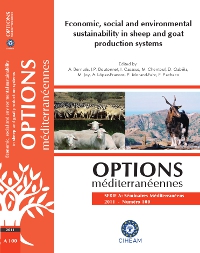| Article précédent | p. 163-167 | Article suivant |
The role of goats in improving crop substrate: Post-ingestion germination and survival of two Mediterranean herbaceous forage species
We assessed the ability of Payoya goats to disperse two endozoochorous Mediterranean herbaceous forage species: Trifolium subterraneum (legume) and Lolium rigidum (grass). Seeds of these two species were fed to six individually housed goats. For five days following ingestion, the faeces were collected every 24 hours. Following examination of the contents of the faeces the percentage of seed loss (chewing and digestion) was determined as well as the distribution of seed recovery over time, germination efficacy and survival of seedlings after passage through the digestive tract. The percentage of seeds recovered was 1.5 percent in T. subterraneum and 2 percent in L. rigidum, whilst germination was between 33-38 percent in T. subterraneum and 35-37 percent in L. rigidum. In the study species, biomass and herbage height was clearly higher in the seedlings emerged from the faeces than in controls. Despite the low values obtained, we can consider that the use of livestock can be a cheap and effective method to introduce new pasture species.
La capacité de dispersion par les chèvres de deux espèces herbacées d'intérêt fourrager : Trifolium subterraneum (Fabaceae) et Lolium rigidum (Poaceae) a été évaluée. Les semences de ces espèces ont été mélangées à la nourriture de six chèvres logées individuellement. Après leur ingestion, les selles ont été récoltées pendant cinq jours chaque 24 heures, les pourcentages de perte de semences (par mastication et digestion) ont été examinés ainsi que la distribution des graines récupérées dans le temps, la germination et l'efficacité de la survie des semis après le passage dans le tube digestif. Le pourcentage de graines récupérées a été de 1,5 pour cent pour T. subterraneum et de 2 pour cent pour L. rigidum, alors que la germination se situe entre 33-38 pour cent pour T. subterraneum et 35-37 pour cent pour L. rigidum. Pour les deux espèces étudiées, la biomasse et la hauteur des individus ont été significativement plus élevées pour les plantes issues de matières fécales que chez les témoins. Malgré les faibles valeurs obtenues, l'utilisation du bétail peut être considérée comme un outil bon marché et efficace pour introduire de nouvelles espèces fourragères d'intérêt.
- [ Afficher ]
- [ Télécharger ]
- [ Exporter la citation ]
Vous pouvez télécharger la citation au format :
- [ Imprimer ]
-
Mots-clés
CHEVRE, GERMINATION DES GRAINES, LOLIUM RIGIDUM, TRIFOLIUM SUBTERRANEUM, ABSORPTION DIGESTIVECiter cet article
Mancilla-Leytón J.M., Martín Vicente A. The role of goats in improving crop substrate: Post-ingestion germination and survival of two Mediterranean herbaceous forage species. In : Bernués A. (ed.), Boutonnet J.P. (ed.), Casasús I. (ed.), Chentouf M. (ed.), Gabiña D. (ed.), Joy M. (ed.), López-Francos A. (ed.), Morand-Fehr P. (ed.), Pacheco F. (ed.). Economic, social and environmental sustainability in sheep and goat production systems. Zaragoza : CIHEAM / FAO / CITA-DGA, 2011. p. 163-167. (Options Méditerranéennes : Série A. Séminaires Méditerranéens; n. 100). 7. Proceedings of the International Seminar of the Sub-Network on Production Systems of the FAO-CIHEAM Inter-Regional Cooperative Research and Development Network on Sheep and Goats, 2010/11/10-12, Zaragoza (Spain). http://om.ciheam.org/om/pdf/a100/00801499.pdf



